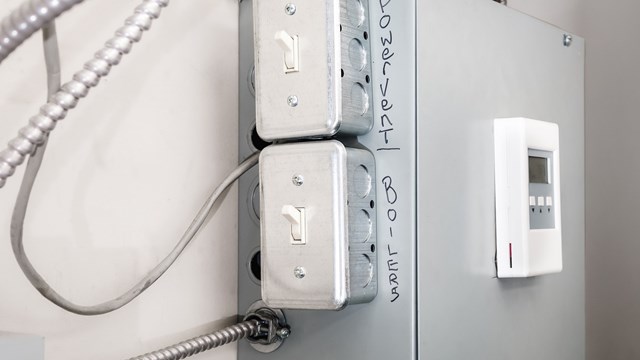
Hundreds of condominium units heated and cooled by geothermal power have recently hit the market in New England, heralding the wholesale arrival of the "green" alternative energy system in this area.
A Case in Point
Most prominent among the new developments is Monarch on the Merrimack, a 600-unit loft conversion of an old mill in Lawrence, Massachusetts. The project is being undertaken by MassInnovations, LLC, of Fitchburg, Massachusetts.
Units at the condominium will be heated and cooled by water that is drawn from 20 wells that were drilled hundreds of feet down to tap the Earth's renewable heat.
In the wintertime, the groundwater, which remains at a consistent temperature of between 50 and 55 degrees, is passed through a heat pump, which works like a refrigerator except in reverse, extracting heat from the water and gently elevating the room temperature in the living areas. In the summer, the heat pump switches modes, pulling warmth from the condominium and transferring it to the circulating water, which is then sent back underground. Because no water is ever used by the geothermal system—it is drawn up and returned at an equal rate—there is no danger of the well ever running dry.
The cost to run a geothermal system is projected to be 25 to 40 percent less than the costs of conventional heating and cooling, or about $50 a month for a 1,200-square-foot unit. In addition, geothermal heat is much safer and cleaner than conventional sources of heat. A heat pump is powered by electricity, so there is no onsite combustion of fossil fuels and no storage of fuels on site, and, as a result of these two differences, much cleaner air in the building and on the property.
That potent combination of economics and safety, along with a technology that is finally ready for primetime, is likely to make geothermal as common as the recycling bin and hybrid-fuel automobile in coming years.
An Emerging Market
Despite its green credentials, people buying into geothermal are not limited to hard-core environmentalists. In fact, they represent a cross-section of the everyday home- buying public.
Constantine Valhouli, principal of the HammerSmith Group, which is marketing the lofts, says that 60 percent of buyers at Monarch on the Merrimack are young professionals and 40 percent are empty nesters.
Buyers moving into the condominiums in Lawrence, a former mill city poised to enjoy a revival, come from many of the surrounding affluent towns, including Andover, North Andover, and Boxboro, and Boston, says Valhouli. A large percentage of the Boston transplants are attracted by the condominium's relatively low prices—a 1,201-square-foot, one-bedroom loft lists for $200,000—and the MBTA commuter rail station directly across the street, which makes it possible to enjoy a comfortable lifestyle without owning a car.
The green-minded residents who decide to live a car-free life will be assisted in their efforts by the developer, who has ambitious plans to turn the former mill into a destination location. In addition to a garden lobby with a waterfall, rooftop terrace and gardens, fitness center, and six-acre private park along the Merrimack River, the converted mill will contain an independent movie theater, art galleries, spas, and a variety of restaurants. The street-level section of the condominium along Merrimack Street will be devoted to small boutiques, following the model of Thayer Street in Providence, a street of eclectic shops that borders Brown University, says Valhouli.
Valhouli says the unusual mix has attracted a demographic very similar to the group that endorsed the whole foods market. That buyer is motivated by a number of factors. "Some people do it out of an ethical sense—it's the right thing to do," says Valhouli. "Other people say it's better for you, a healthier choice. And some people just say, 'It tastes better.'"
That blend of green appeal and economics has helped the mill conversion stand out in a market that's crowded with condominiums of all stripes, says Valhouli. "We actually have a competitive advantage because we're one of the few branded and lifestyle-based buildings. I'd say [we're] one of the only ones in the area," says Valhouli. "If people like what we have, they can't go elsewhere to get it."
Developers Must Be Knowledgeable
While the economics of geothermal are immediately apparent in the lower utility bills that residents receive, there is a downside for developers, says John Geyer, principal of John Geyer and Associates in Vancouver, Washington. Geyer, a certified geothermal designer, says that geothermal typically costs twice as much to install as conventional heating units. But once the units are installed, says Geyer, savings accrue in a number of ways. Because heat pumps easily last 25 years—twice as long as a gas- or oil-fired furnace—the increased installation costs are covered by "avoiding a replacement cycle" that would come with a conventional unit, he says.
"At the residential level, we often say it's twice as much to install, and half as much to operate, but it lasts twice as long," says Geyer.
Another problem facing a developer who is interested in installing a heat pump is the lack of local tradesmen who have experience with this type of installation, according to developer Richard Lincoln, who is currently marketing Wayside Farm in East Bridgewater, Massachusetts, a 66-unit condo- minium with a geothermal system.
"The well drillers and the plumbers had never dealt with it before, so there was a learning curve in the early units," says Lincoln, who notes that by the end of the project, many of the tradesmen were inquiring about installing geothermal at their own homes.
Another learning curve involves educating prospective home purchasers, says Lincoln. "We have to explain the mechanics of geothermal to buyers, to start at square one. No one is very familiar with it," says Lincoln, who tells prospective buyers that his 2,000-square-foot condominium units will cost less than $100 a month to heat and cool.
A Bumpy Past
Consumers are not the only ones who lack current information about geothermal technology, says Ralph Kenney, president of Legend Construction in Westminster, Massachusetts.
"There's a lot of old stories and a lot of engineers. But a lot of these engineers aren't familiar with the new equipment in geothermal, the next generation. And their opinions are often based on old equipment," says Kenney, who exclusively develops geothermal.
Engineers and other professionals who dealt with second- or third- generation geothermal equipment are often under the impression that it breaks down frequently, is an energy hog, and is overly large and, therefore, difficult to install, Kenney says. "They [geothermal units] used to be the size of refrigerators, and you needed two or three of them to do a 3,000-square-foot house," says Kenney. But today, he notes, a fifth-generation heat pump has been reduced in size to a cube that measures two feet square and is "very, very efficient."
Developers Step Forward
Geothermal's rocky start and the resultant consumer skepticism meant that Lincoln's decision to pursue the technology translated to taking a big risk, says Lincoln, who spent about $12,000 more per unit to install geothermal.
"That was the tough part for us. You're not winning any awards and there's actually a little more work to do with the consumer," says Lincoln. "Everybody's interested in saving money, but there's fear of the unknown and you've got to talk them through it."
Despite that risk, Lincoln is committed to geothermal, and he is certain the technology is the wave of the future. "I think it's analogous to the SUV. People are still buying cars that get 14 miles to the gallon. If we were at the next level of energy prices—and I think we will be in a few years—people will be forced to think about this."
Geyer already sees big business on board for what is expected to be a coming boom in geothermal. Major corporations like Crane, York, and Carrier are all producing geothermal heat pumps, and they are positioning themselves for when the market takes off from its current rate of 80,000 new residences every year, he says.
Their interest, Geyer says, is based both on the growing popularity of green power and, more importantly, on the overwhelming economic advantage that geothermal brings to the table.
"The most rapid growth is in large-scale projects like Lawrence, where investors recognize the economics. To date, geothermal advocates have been primarily members of the green movement, or those seeking safety or better comfort. But the real motivation for owners and users are economics, and these [geothermal devices] are the lowest cost heating and cooling devices in existence."





Comments
Leave a Comment